February 2019 weather-wise, for the first week at least, continued where January left off, with northerly winds bringing plenty of snow and frosts and a typically wintry feel... then suddenly, and very unexpectedly, the winds switched direction, with southerlies bringing warm air up all the way from north Africa and giving us record high temperatures for February and three weeks of unseasonably spring-like conditions - great for us humans, but very confusing for the wildlife!
So with the days lengthening, snowdrops and crocuses blooming, woodpeckers drumming, songbirds singing, Bumblebees flying and temperatures in double figures for much of the month, it actually felt more like April than February!
Full-day local safari bird lists increased a little this month, with most of our winter visitors lingering and the first returning waders pushing numbers up into the high 40's, though a trip to the nearby Moray Coast or Black Isle can increase this number considerably, whilst mammal day lists varied between 4 and 8 species depending on the time of our start, duration of safari and number of habitats visited, with early starts usually proving more successful for the shyer creatures.
 |
| Late winter in a beautiful upland glen |
To give you an idea of what you may realistically hope to see if you are planning a future
February visit yourself, I hope the following more detailed information, illustrated with photos taken in and around the Cairngorms National Park and nearby Moray coast, by myself , my friends or my safari clients will help - clicking on the picture will enlarge it to full screen.
Wildlife highlights:
Local speciality/upland bird species seen regularly during the month included:
Black Grouse (at or soon after dawn only),
Red Grouse,
Crested Tit ,
Dipper , Goldeneye and Goosander, we also had some decent sightings of
Snow Bunting before the snowline receded..., and a few brief glimpses of
Crossbills...
Winter visiting birds were represented by family groups of
Whooper Swans and
several species of 'grey'
Geese, .. a few
Waxwings,
Bramblings and
Redpolls were seen.and a couple of
Great Grey Shrikes appeared locally from mid-month...
A good variety of
seabirds,
waders, wildfowl and
Geese were enjoyed at the
Moray Coast and the nearby inland lochs...
Mammals seen regularly locally during the month included:
Roe Deer, Red Deer, Reindeer, Red Squirrel, Rabbit, Mountain Hare (white
), and
Mountain Goat, with a couple of sightings of
Brown Hare and
Sika Deer...
Common Seal and
Grey Seal were both seen at the nearby Moray Coast...
February 2019 bird sightings in more detail:
 |
| Lekking Black Grouse |
Dawn (still a pretty user-friendly 7 am) on my safaris was usually spent at a local
Black Grouse lek site, usually a raised grassy area, where we enjoyed the spectacle of up to 11 of these attractive, and sadly, increasingly rare, blue-black cock birds displaying, posturing aggressively and flutter-jumping in a bid to out-display and intimidate their opponents in a bid to secure their little patch of the moorland 'arena' for the forthcoming breeding season, all accompanied by their strange bubbling and whooshing calls drifting across the moor... surely one of British wildlife's 'must-see' (and 'must hear') experiences? 'Performances' were noticeably better on cold, still mornings.... but please be aware that sightings are not 'guaranteed' as the birds can fail to show in very mild or wet and windy weather....
 |
| Male Red Grouse |
Still on the moors, our local
Red Grouse adopt a different approach to the breeding season, with the males choosing a 'territory', then defending it from rivals, and attempting to attract a mate, with much calling and posturing and red eye wattles aglow, from the few higher vantage points, making them nice and easy for us to find!
 |
| Crested Tit by Bob Smith |
In the Caledonian pine forests, our local
Crested Tits continued to show well at my favourite forest feeding stations early in the month when conditions were wintry, especially soon after dawn, and particularly on the colder days, when they are presumably at their most desperate for food, with up to 3 of these true 'local specialities' showing at once...however... they became noticeably more elusive when things warmed up , and we actually had quite a few 'no-shows' as the month progressed ...though of course, if you know their distinctive calls and song, you do have a chance of seeing one whilst walking in the forest....
It is well worth noting that the colder winter months (October-Feb) are actually the best time of year for seeing the 'wee Cresties', as these characterful little birds can be frustratingly secretive, unobtrusive and almost silent during the breeding season, with sightings being much more difficult to obtain between March and September....
 |
| Male Crossbill |
Continuing the forest theme, I was all set to 'cut and paste' my usual
Crossbill sightings report saying "sadly,
Crossbill sightings were, as usual, limited to very brief glimpses of birds flying over, with us only being able to identify them by their characteristic 'jip-jip' calls".. and that was indeed the case... up until the 27th, when a lovely male bird (at last!!) posed for me for a few seconds, and I actually managed a photo! Hallelujah!
Still in the forests, sadly, it is not such good news on the
Capercaillie front... despite 13 pre-dawn walks, and many slow drives through (previously) good 'Caper' territory this year... I have still to see one myself this year.... let alone find one for my clients to see.....and I am not alone in struggling....worrying times for this iconic Highland species....
 |
| Dipper with nesting material |
On the rivers, our
Dippers are in full 'breeding season mode' now, and early morning visits to known favourite nesting sites (keeping a respectful distance of course) gave us great views of these characterful and hardy little birds singing their hearts out, with wings back and chests pushed out... and toward the end of the month we even saw one delivering nesting material....
 |
| Young Golden Eagle (they lose the white patches as they mature) |
 |
Common Buzzard (note the proportionately shorter wingspan and diagnostic white breast band)
|
Golden Eagle is a rare, iconic, localised and much sought-after bird in the UK, and as I have mentioned before, the shorter days of the winter months give us our best chance of seeing them.
This month continued the trend, and early in the month we were lucky enough to enjoy several memorable sightings of these majestic birds hunting in upland glens, though not as many as last month....
Raptors in general were again pretty well represented this month, with
Kestrel,
Sparrowhawk,
Common Buzzard, Peregrine, Goshawk and
Red Kite all being seen at least once...though I have still yet to see a
White-Tailed Eagle this year.....
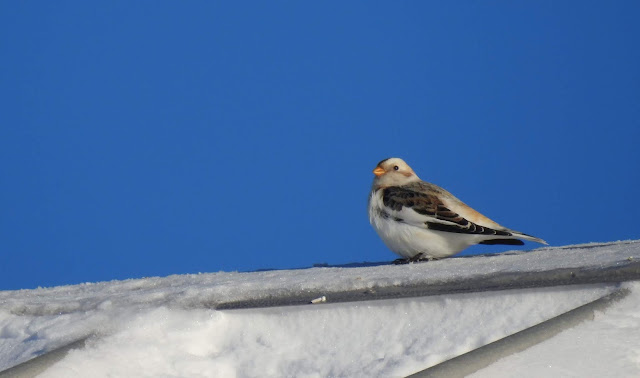 |
| Snow Bunting |
With the Cairngorm Funicular Railway still out of action for major repairs, and the snow-line receding way up towards the summit plateau making it likely that the Ptarmigan and Snow Buntings would do likewise...I didn't venture up into the mountain-tops myself this month, but we did manage some decent views of the Snow Buntings at lower levels during the first week...and a few intrepid birders who made the effort to walk up to the tops did manage a few Ptarmigan sightings....
 |
| Waxwing |
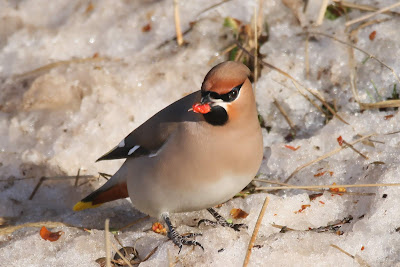 |
| Waxwing by Steve Nicklin |
With very few berries left now, our remaining Waxwing flocks became very mobile in their search for food so sightings were a bit patchy, with them being seen in a hotel garden, a couple of car parks and a disused railway station among other places....but we still managed some great views, with many of my safari clients seeing these truly beautiful birds for the first time..
 |
| Brambling |
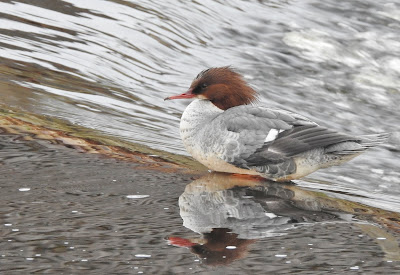 |
| Female 'redhead' Goosander |
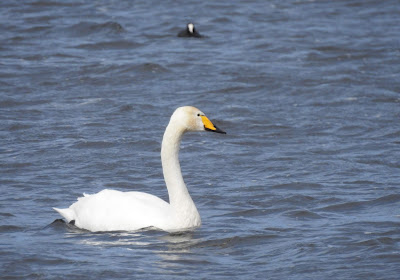 |
| Whooper Swan |
 |
| Great Grey Shrike - apologies for poor quality pic - taken at long range through a heat haze... |
Other good birds seen or reported locally this month included: Whooper Swan, Goosander, Goldeneye, Brambling, Redpoll, Bullfinch and Great Grey Shrike....
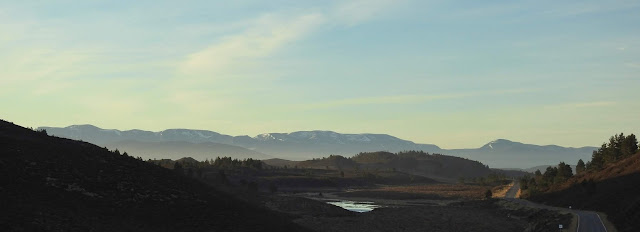 |
| Sunrise over the Cairngorm Mountains as seen from a local upland moor |
Moray coast highlights:
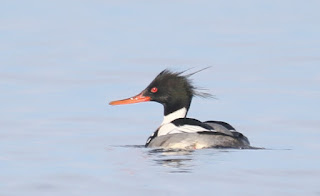 |
| Red-Breasted Merganser by Steve Nicklin |
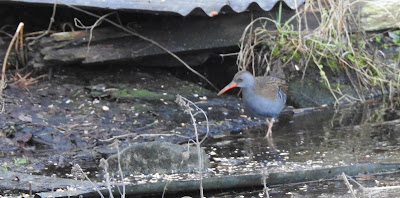 |
| Water Rail |
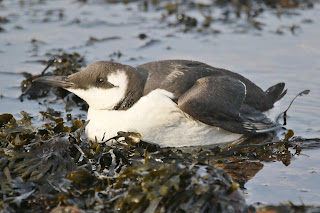 |
| Guillemot by Steve Nicklin |
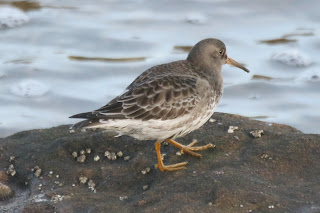 |
| Purple Sandpiper by Steve Nicklin |
 |
| Male Eider |
 |
| Long-Tailed Ducks |
 |
| Red-Throated Diver by Steve Nicklin |
The Moray coast is only about a one hour drive north of Aviemore, and my trips to favourite reserves, lochs, bays and harbours gave good views of wintering birds such as Greylag Geese, Pink-Footed Geese, Whooper Swan, Water Rail, Eider, Wigeon, Teal, Scaup, Pintail, Bar-Tailed Godwit, Black-Tailed Godwit, Knot, Golden Plover, Ringed Plover, Purple Sandpiper, Common Scoter, Velvet Scoter, Red-Throated Diver, Guillemot, Goosander, Red-Breasted Merganser,and Long-Tailed Ducks....
 |
| Lossiemouth Bay on the picturesque Moray coast |
February 2019 mammal sightings in more detail:
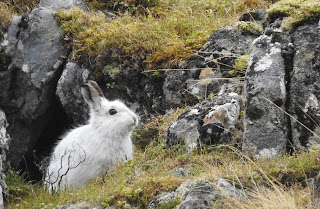 |
| Mountain Hare in it's typical habitat.. |
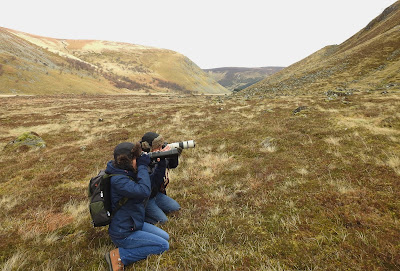 |
| Stalking Mountain Hares... |
 |
| Mountain Hare by Michelle and Phil Coyle |
Our local
Mountain Hares once again 'stole the show' this month, and it is very hard to argue against them regularly being voted as 'mammal of the day' when you take into account their gorgeous looks in their winter white coats, their relative scarcity in the UK, and the often spectacularly scenic upland habitat in which they are found. I was 'hired' for Mountain Hare photography safaris by several keen wildlife photographers this month, and I'm pleased to say that we achieved good results on most occasions, but it should be noted that it can often involve a lengthy walk on rough and often steep terrain....
 |
| Red Deer |
 |
| Red Deer stag |
Still up in the glens, Red Deer could often be seen well in their large same-sex herds, well, on the days when no shooting was taking place anyway!.... but only if you used a bit of fieldcraft, and concentrated on looking for them on the leeward side of the hills, as although they are pretty hardy, they are clearly sensible enough not to stay exposed to a strong wind....
 |
| Feral Mountain Goats |
Also sharing the same upland habitat are
Feral Mountain Goats, and we did much better this month, seeing them on nearly every occasion we visited the glens where they live, and although they were keen to keep their distance, there now appeared to be some youngsters among them...
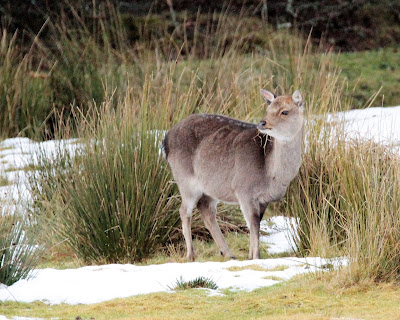 |
| Sika Deer by Jan Shields |
Sika Deer were encountered on a few occasions on my safaris this month, with many of my clients seeing them for the first time. For those not familiar with this species, they originate from Asia and were introduced into the UK in the late 19th century...
 |
| Roe Deer by Steve Nicklin |
Roe Deer however, can be a little trickier to see, being more wary of human disturbance, and most of our sightings were at dawn or in very remote areas, and were usually of the 'brief' variety, as they ran away on becoming aware of us...
 |
| What a poser! Red Squirrel by Jan Shields |
In our local Caledonian forests,
Red Squirrels put big smiles on my safari clients faces, with many of them seeing these rare cute and characterful little animals for the first time. Although most of our sightings are at feeding stations - they love peanuts! - we also had plenty of 'random' sightings of them whilst driving or walking along the quieter tracks...
Unusually for February, and undoubtedly due to the unseasonably mild weather, we also had our first sightings this year of
Frogs, Toads and
Bumblebees....at least a month earlier than normal!
Summary:
Well, after a quiet January, things really took off for my safaris this month, the great weather, half-term holidays and the continued 'Winterwatch effect' all combined well to keep me nice and busy, with loads of great wildlife seen, and my safari clients all seemed to have a great time., as did I!!
 |
| The Winterwatch teepee on the edge of Abernethy Forest |
If you think you know someone who may enjoy a taste of what I do, why not treat them to a safari gift certificate. They make a thoughtful and imaginative present, are available for any amount and are valid at any time within a year from date of purchase....









